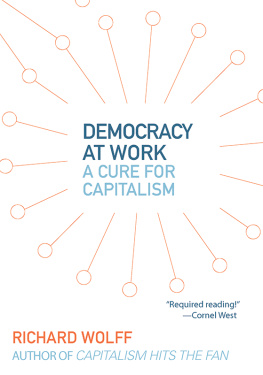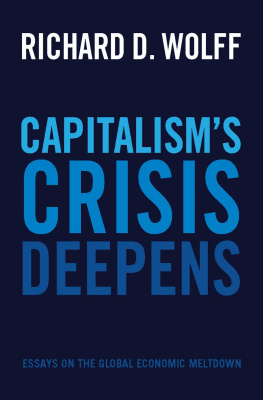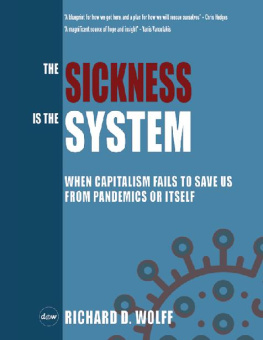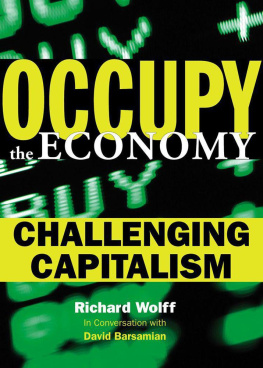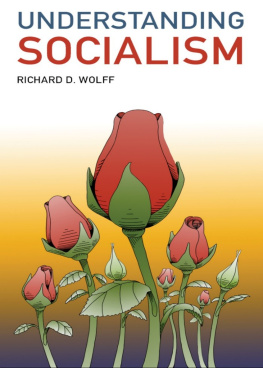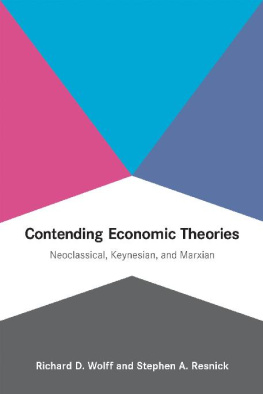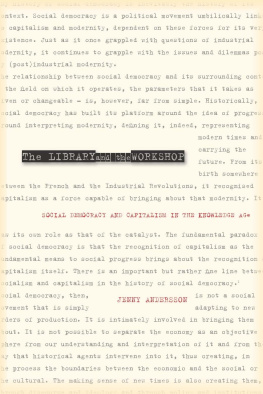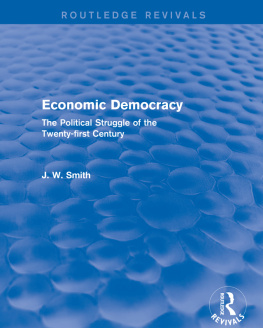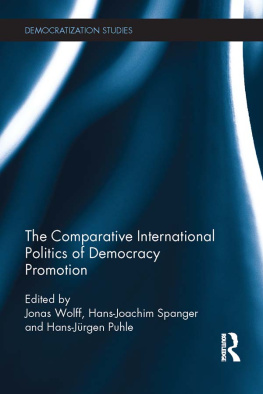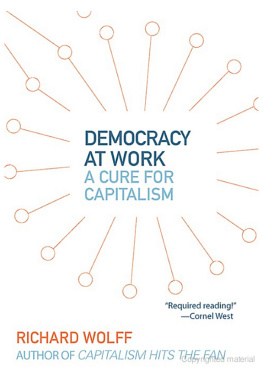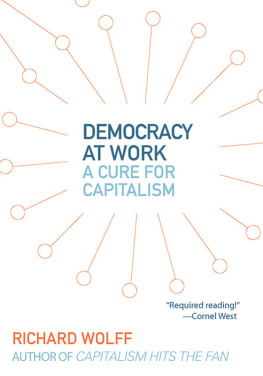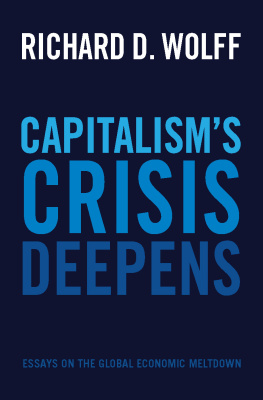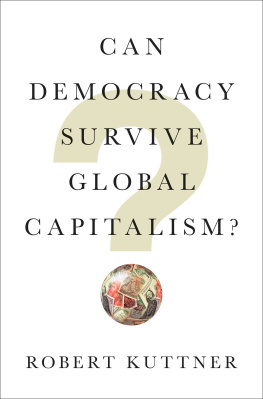Contents
Introduction
Cascading economic problems and crises, coupled with dysfunctional political responses, have plunged modern societies into deepening turmoil. Capitalismthe dominant economic system of our timehas once again become the subject of criticism and opposition. A global capitalist system that no longer meets most peoples needs has prompted social movements everywhere to arise and coalesce in the active search for systemic alternatives. Yet the particular versions of anticapitalismthe various forms of state socialism and communismthat actually prevailed over the last century no longer seem to offer a model or inspiration to those looking for an alternative to capitalism. People are looking for a new solution, a new cure for capitalisms injustices, waste, and massive breakdowns. This book offers one such cure.
In presenting the idea of workers self-directed enterprises (which I will call WSDEs throughout this book), I offer a new version of an old idea: that production works best when performed by a community that collectively and democratically designs and carries out shared labor. In analyzing capitalism to show its shortcomings and in establishing how WSDEs would overcome them, I use Karl Marxs theory of the production, appropriation, and distribution of the surplus, his class analysis. In contrast, this book about workers self-directed enterprise analyzes WSDEs in relation to capitalism and advocates them as a superior way to organize production.
The United States has recently suffered five years of the worst economic crisis since the Great Depression of the 1930s. For most people, the end of this crisis is not in sight. Tens of millions remain unemployed, many for extended lengths of time. Unprecedented numbers of foreclosed and homeless people live not far from unprecedented numbers of homes that stand empty. Wages and benefits are trending downward while profits are simultaneously increasing. Just as these conditions force millions to need and want more from local, state, and federal governments, officials continue to announce ever more cutbacks in public services. This crisis is reminding millions about capitalisms inherent instability, its historic failure for centuries to prevent the recurrence of downturns, and how poorly, unjustly, and cruelly it typically manages them.
A Tale of Two Crises
The current economic crisis comes after a period of thirty years during which business interests rolled back the New Deal that saved capitalism during the Great Depression of the 1930s. There is more than a little irony in that story. The three years after the 1929 crash both shook and ended capitalisms roaring 1920s, as well as the Republicans hold on the presidency. A centrist Democrat, Franklin D. Roosevelt, became president. He and his party worriedas did Republicans thenabout deficits and balancing Washington budgets. FDR began his presidency acting much like most leading Democrats today. But the Depression provoked and strengthened forces that changed him. Those forces both pressed him and enabled him to change his policies and thereby become the most progressive and the most popular president in US history.
The Great Depression provoked the formation and immense successes of the Congress of Industrial Organizations (CIO). The CIO organized millions of industrial workers into unions for the first time, bringing about the greatest unionization wave in US history. Members and leaders agreed that unions were working peoples best weapons against the ravages of a severely depressed capitalism. They confronted employers (with job actions, strikes, and collective bargaining) and politicians (by mobilizing union members and their money for both electoral and non-electoral campaigns). The CIOs demands for jobs and for direct government help to the average American changed political conditions in the 1930s. The CIO undermined the conservative or centrist Democratic program of the time (what today would be called austerity).
The Great Depression also drove into high gear a variety of socialist and communist groups, movements, and parties. Inside and outside the CIO, they mobilized large numbers of workers, students, farmers, and others. These left organizations mixed (1) public campaigns for jobs and better living conditions for the mass of Americans, (2) systematic electoral work, often coordinated with the CIO and other unions, and (3) more or less revolutionary demands aimed at transition from capitalism to socialism.
Together, the CIO, socialists, and communists made it impossible to continue policies that managed the Great Depression by bailing out the banks and major corporations, keeping government economic intervention otherwise minimal, and leaving the unemployed and foreclosed basically unassisted. At the same time, the CIO, socialists, and communists brought millions into the streets shaking their fists. They criticized business and capitalism more and more intensely. Those actions prompted and enabled FDR to present big business and the richest citizens (the business and power elite that included his own family) with a plan.
On the one hand, they could accommodate FDRs demands for taxes on business and the rich to be used to meet major social welfare demands of the CIO, socialists, and communists. FDR believed he could thereby satisfy enough mass social needs to preserve the capitalist ownership and production systems intact, though they would be more regulated than before. On the other hand, if big business and the rich refused, FDR warned that they would soon face a population led by increasingly anticapitalist forces seeking much more fundamental changes to the system.
FDRs plan split the ranks of big business and the rich. Enough of them agreed to higher taxes on business and the rich to allow FDR to offer a parallel deal to the left. He urged them to be reformers, not revolutionaries: to keep demands for going beyond capitalism at the level of rhetoric but not take them into practical politics.
FDR built a powerful political partnership between that part of big business and the rich he had won over and the unions and the left, despite some dissenters on both sides of the equation. That partnership never fundamentally challenged boards of directors dominant control over US corporations. Major private shareholders continued to select boards of directors who continued to make the basic decisions of what, how, and where to produce and where to distribute the surpluses they appropriated from their workers.
FDRs partnership proceeded to construct a kind of social democracy or welfare state in the United States, a genuine New Deal. FDR promised that such a program would get US capitalism out of the Depression, provide better lives to most Americans quickly, and prevent future depressions. The only alternative to the New Deal, FDR warned, would be deepening economic and social divisions, tensions, and conflicts.
The partnership was crafted from both sides. One side was comprised of business leaders and wealthy citizens, led by FDR, who believed it necessary and expedient to accommodate left forces unleashed and strengthened by the Depression. On the other side were those leaders of the CIO, socialist, and communist movements who saw reform as the most that could be accomplished and revolution as premature at best and far too dangerous a gamble at worst. To FDRs right, a considerable number of big businesses and rich Americans rejected his political partnership and steadfastly opposed its social democratic program. To FDRs left, some radicals and revolutionaries also rejected the partnership as a reformist sellout of the movement to overturn capitalism.
FDRs partnership prevailed politically. In the depths of the Great Depression, it launched costly programs that helped many millions (especially remarkable given what has not happened in the economic crisis since 2007). An expensive Social Security system was established to provide public pensions to the mass of US workers. An expensive federal unemployment insurance system was established to directly assist the unemployed. Expensive federal hiring programs were established that created and filled more than twelve million jobs during the Depression years after 1934. At a time when employers, employees, and government officials all complained of depleted revenues and funds, Washington found and spent vast sums directly to ease the suffering of working people and to stimulate a deeply depressed economy.

